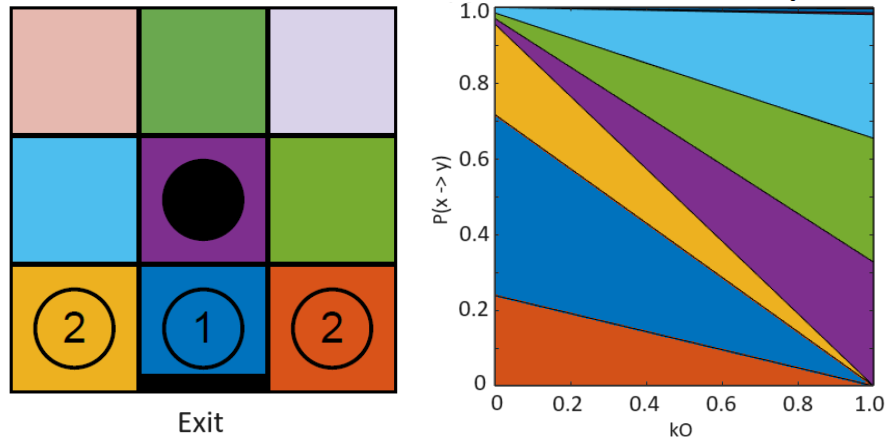Heterogeneity of Agents in Cellular Evacuation Model Explains the Decreasing Bottleneck Flow
DOI:
https://doi.org/10.17815/CD.2024.162Keywords:
Pedestrian flow, Floor-field model, Agents' heterogeneity, Bonds, AggressivenessAbstract
Heterogeneous crowd consisting of pedestrians with essentially diverse abilities behaves in certain aspects differently than a homogeneous crowd consisting of "average" pedestrians. This study investigates the influence of heterogeneity in aspects connected to the ability to navigate through a crowd in front of a bottleneck. Simulations of cellular multi-agent model suggest that the heterogeneity in ability to push through the crowd (represented by aggressiveness) and willingness to bypass the crowd (represented by sensitivity to occupation) may be responsible for the bottleneck flow decreasing in time – a phenomenon observed in experiments.
References
Liao, W., Tordeux, A., Seyfried, A., Chraibi, M., Zheng, X., Zhao, Y.: Detection of steady state in pedestrian experiments. In: Knoop, V.L., Daamen, W. (eds.) Traffic and Granular Flow '15, pp. 73-79. Springer International Publishing, Cham (2016). doi:10.1007/978-3-319-33482-0_10
Hrabák, P., Bukáček, M., Kielar, P., Borrmann, A.: Pedestrian flow through complex infrastructure, experiments, and mass-transport processes. In: Hamdar, S. (ed.) Traffic and Granular Flow '17, pp. 159-166. Springer, Cham (2019). doi:10.1007/978-3-030-11440-4_19
Bukáček, M., Hrabák, P., Krbálek, M.: Microscopic travel-time analysis of bottleneck experiments. Transportmetrica A: Transport Science 14(5-6), 375-391 (2018). doi:10.1080/23249935.2017.1419423
Hrabák, P., Bukáček, M.: Influence of agents heterogeneity in cellular model of evacuation. Journal of Computational Science 21, 486-493 (2017). doi:10.1016/j.jocs.2016.08.002
Burstedde, C., Klauck, K., Schadschneider, A., Zittartz, J.: Simulation of pedestrian dynamics using a two-dimensional cellular automaton. Physica A: Statistical Mechanics and its Applications 295(3 - 4), 507 - 525 (2001). doi:10.1016/S0378-4371(01)00141-8
Schadschneider, A., Chowdhury, D., Nishinari, K.: Stochastic Transport in Complex Systems: From Molecules to Vehicles. Elsevier Science B. V., Amsterdam (2010). doi:10.1016/C2009-0-16900-3
Li, Y., Chen, M., Dou, Z., Zheng, X., Cheng, Y., Mebarki, A.: A review of cellular automata models for crowd evacuation. Physica A: Statistical Mechanics and its Applications 526, 120752 (2019). doi:10.1016/j.physa.2019.03.117
Li, Y., Chen, M., Zheng, X., Dou, Z., Cheng, Y.: Relationship between behavior aggressiveness and pedestrian dynamics using behavior-based cellular automata model. Applied Mathematics and Computation 371, 124941 (2020). doi:10.1016/j.amc.2019.124941
Yanagisawa, D., Yamazaki, K.: Detecting aggressive agents in egress process by using conflict data in cellular automaton model. Journal of Intelligent Transportation Systems 25(6), 626-643 (2021). doi:10.1080/15472450.2021.1942869
Šutý, M.: Conflict solution in cellular evacuation model. Bachelor's thesis, Czech Technical University in Prague, Prague, Czechia (2021). Available at https://dspace.cvut.cz/handle/10467/95146
Hotlib, M.: Exit definition influencing simulation of evacuation in agent-based models. Master's thesis, Czech Technical University in Prague, Prague, Czechia (2023). Available at https://dspace.cvut.cz/handle/10467/107382
Bukáček, M., Hrabák, P., Krbálek, M.: Cellular model of pedestrian dynamics with adaptive time span. In: Wyrzykowski, e.a. (ed.) Parallel Processing and Applied Mathematics, Lecture Notes in Computer Science, vol. 8385, pp. 669-678. Springer (2014). doi:10.1007/978-3-642-55195-6_63
Hrabák, P., Gašpar, F.: Spatially dependent friction-a way of adjusting bottleneck flow in cellular models. In: Zuriguel, I., Garcimartin, A., Cruz, R. (eds.) Traffic and Granular Flow 2019, Springer Proceedings in Physics, vol. 252, pp. 103-109. Springer, Cham (2020). doi:10.1007/978-3-030-55973-1_13
Yanagisawa, D., Ezaki, T., Tomoeda, A., Nishinari, K.: Influence of velocity variance of a single particle on cellular automaton models. In: Chraibi, M., Boltes, M., Schadschneider, A., Seyfried, A. (eds.) Traffic and Granular Flow '13, pp. 495-503. Springer International Publishing, Cham (2015). doi:10.1007/978-3-319-10629-8_55
Kirchner, A., Nishinari, K., Schadschneider, A.: Friction effects and clogging in a cellular automaton model for pedestrian dynamics. Phys. Rev. E 67, 056122 (2003). doi:10.1103/PhysRevE.67.056122
Muggeo, V.M.R.: Estimating regression models with unknown break-points. Statistics in Medicine 22(19), 3055-3071 (2003). doi:10.1002/sim.1545
Pilgrim, C.: piecewise-regression (aka segmented regression) in python. Journal of Open Source Software 6(68), 3859 (2021). doi:10.21105/joss.03859

Downloads
Published
How to Cite
Issue
Section
Categories
License
Copyright (c) 2024 Pavel Hrabák, Matej Šutý, Mykola Hotlib

This work is licensed under a Creative Commons Attribution 4.0 International License.
Authors contributing to Collective Dynamics agree to publish their articles under the Creative Commons Attribution 4.0 license.
This license allows:
Share — copy and redistribute the material in any medium or format
Adapt — remix, transform, and build upon the material
for any purpose, even commercially.
The licensor cannot revoke these freedoms as long as you follow the license terms.
Authors retain copyright of their work. They are permitted and encouraged to post items submitted to Collective Dynamics on personal or institutional websites and repositories, prior to and after publication (while providing the bibliographic details of that publication).








